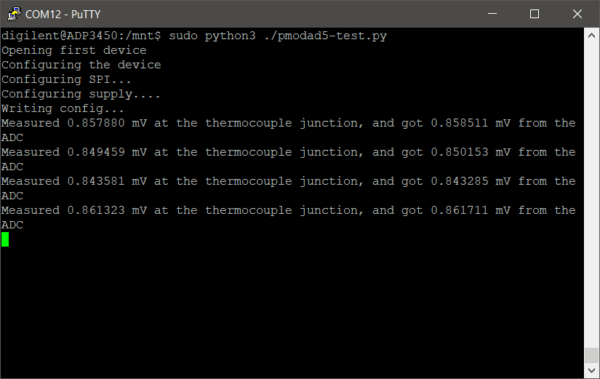Folks, you can pack up and go home. Literally – that’s what we want you to do. Our new ADP3450 gives you the ability to move your lab into your living room with four high resolution channels, the same 12-in-1 mixed signal measurement experience as its little brother (the Analog Discovery 2), memory depth, specs, and network capability to make sure the transition is as smooth as it can be. A powerful SDK allows advanced control and triggering when used as an instrument or in a stand-alone embedded mode. For analog instruments, the ADP3450 features four 14-bit analog inputs, two 14-bit analog outputs, and two triggers on industry standard BNC connectors, so engineers can take advantage of the flexibility of a USB device while ensuring the best signal integrity for their high-resolution measurements. With the addition of oversampling to the oscilloscope instrument in WaveForms, the analog inputs can acquire at 0.5 GS/s sampling rate with over 55 MHz bandwidth. For the logic analyzer and digital instruments, 16 digital inputs and outputs are available via MTE cables, offering configurable digital settings including a flexible voltage threshold and output current drive.
WaveForms is Still Groovy
If you’ve been working with our free-to-download and free-to-use software, WaveForms, in the Analog Discovery 2 or Analog Discovery Studio, you’ll be quite relieved to know that the Analog Discovery Pro is compatible with it. You’ll be able to access all of the instruments through the same GUI in Standard Mode. With WaveForms SDK, you can interact with Linux Mode for a more customizable experience.

Networking and Linux Mode
The ADP3450 also offers the ability to connect to a network via ethernet, allowing the user to write a test on the device and deploy or monitor it remotely with increased streaming speeds. Additionally, Linux Mode provides an on-device operating system that, when combined with WaveForms SDK, gives the flexibility to create a unique embedded test system and enables the USB host ports, providing access to a variety of USB connected peripherals, such as a WiFi dongle. To see how Linux Mode works on the ADP3450 with WaveForms SDK, see this handy demo. Once you’ve created a script or application, you’ll then be able to take advantage of faster data streaming via ethernet/network connectivity.

What You See is What You Need
Often with professional benchtop equipment, you start with a base price, and each feature you’re interested in jacks up the overall cost of the product. Not so with the Analog Discovery Pro. Not only is what you see what you get, what you see is what you need. Over the past few years, we’ve taken feedback and recommendations on our other products, culminating in an instrument that addresses the needs of our engineer customers. There’s nothing extra here. No misleading specs. No hidden costs. And if the ADP3450 is too much, the two-channel ADP3250 might be a better fit for your work station (and your wallet). If you’re wanting even more performance, we’ll be releasing the ADP5250 later this year.
TL;DR (too long; didn’t read):
This is an exciting time for Digilent. If you don’t believe me, ask Steve Johnson about the direction he thinks engineering is headed, and how we fit into it. The ADP3450 takes the utility and processing power of PC-connected USB instruments to the level of stand-alone benchtop equipment, and its our first test and measurement device adding network connectivity. To learn more about it, watch this video or visit the resource center to see specs and more.


Reference: https://store.digilentinc.com/analog-discovery-pro-3000-series-portable-high-resolution-mixed-signal-oscilloscopes
Reference: ADP3450-Rear_Side-1000__73603.1611688929.png
Please note the 19 parallel, vertical slots on the side with the power switch.
Does the ADP3450 have internal fans, or are the slots for cooling via passive airflow?
Thanks,
Bob
Hi Bob! Cooling is via passive airflow only.
Regarding the ADP5250: can you give an estimate of the sampling rate, bandwidth, number of analog inputs, and price? E.g., complete the table below:
Sampling Rate (GS/s) Bandwidth (MHz) Analog Inputs Approx. Price
ADP3450 0.5 55 4 $1.3K
ADP5250 ? ? ? ?
Thanks,
Bob
SO the ADP5250 will have a sampling rate of 1 GS/s single channel, 500 MS/s/channel dual channel, a bandwidth of 100 MHz, and two analog channels. We’re still working on hammering out the price point, so you’ll excuse us if we keep that private for the time being!
Thanks so much for the quick replies.
I’m a little slow; I now see your model number naming logic; I could have answered one of my questions myself.
Will there possibly be a ADP5450, which would be the same as the ADP5250 but with 4 analog channels?
Thanks,
Bob